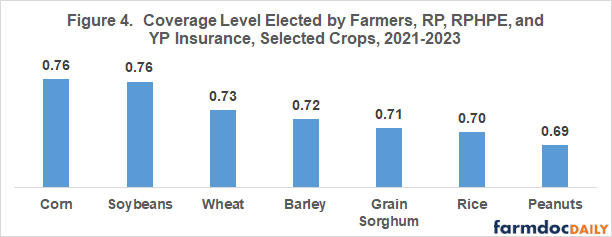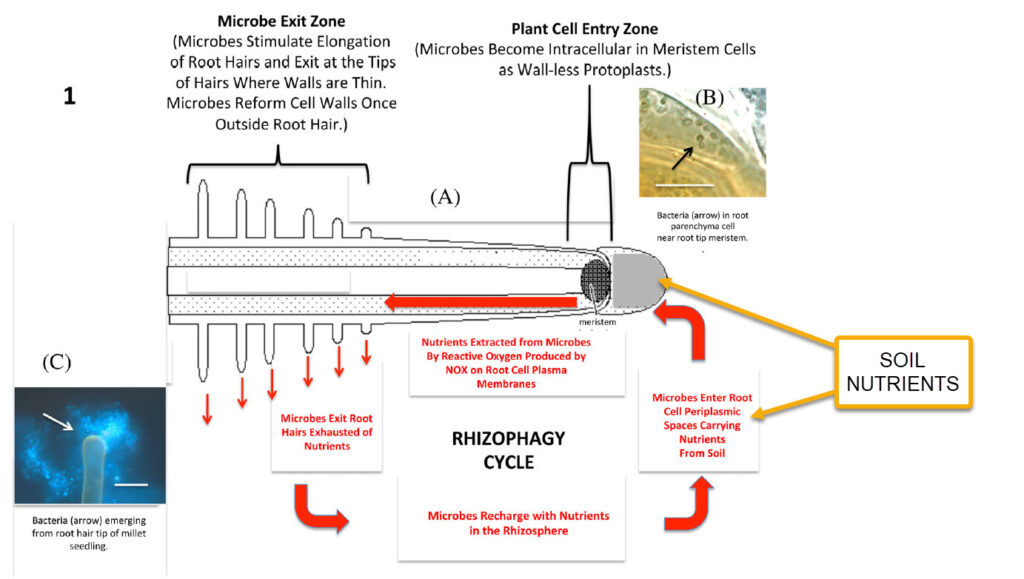By Andrew McGuire
If you’ve heard of rhizophagy or quorum sensing, it’s probably because of regenerative agriculture. The movement has popularized these soil processes through videos, articles, social media influencers, and even a researcher or two, painting them as solutions that reduce or eliminate the use of synthetic fertilizers and pesticides. Yes, plants really can get nutrients directly from microbes by rhizophagy, and yes, bacteria really communicate with chemicals to coordinate actions through quorum sensing. However, does this matter for crop production? Let’s take a careful look at these processes.
Roots eat microbes, spit some out
Rhizophagy means “root eating” and refers to the process of microbes, usually bacteria, entering plant root tissues. The plant then breaks down the bacteria and takes their nutrients. Some bacteria survive and return to the soil, creating the rhizophagy cycle. Research suggests plants gain elements like nitrogen, iron, or other minerals through this process. James White and colleagues at Rutgers University have published several papers using microscopy to detail the mechanisms involved (White et al., 2018, 2019).
White has also popularized rhizophagy within regenerative agriculture through podcast interviews and videos with thousands of views. There are articles and social media posts about rhizophagy, a book, and even a fee-based regenerative ag course on the topic. It’s fascinating science, but does it have any practical use in crop production?
Questioning Rhizophagy
To clarify just how important rhizophagy is to crop production, let’s ask a series of questions.

Is it new or is it already in cropped soils?
While current science is opening the soil’s black box of processes, this does not mean anything changes. Just because we uncover a soil process does not mean it is new. More likely, it has long existed beneath our feet, subtly influencing nutrient cycling and plant growth without our knowing how it operated. Our recent insights may be less a revolutionary breakthrough than an explanation of how these natural interactions have always supported agriculture. This is the case for rhizophagy, at least in wild plants. It has always been there working.
For crops, there is some evidence that endophytes, those bacteria that enter the plant and then survive to leave it, have been lost in the breeding process and modern farming techniques. So, if we could restore these crop endophytes, we might have a new way of getting nutrients.
This brings up a big problem for rhizophagy: nearly all the research has been done in the lab with microscopes, with a few greenhouse trials. I didn’t find any field trials where endophytes had been restored in crops and the resulting rhizophagy boosted nutrient levels. For now, let’s assume this research is out there. Next question.
Can we manage it?
This is often a useful question to ask about soil processes relying on microbes. Soil microbial populations can be highly variable, influenced by pH, moisture, temperature, organic matter, and other factors. So how do you manage them to take advantage of rhizophagy?
A review (Quiza et al., 2015) on the topic of endophytic microorganisms, including rhizophagy, listed the following possible management:
- Crop rotation
- Fertilizers and organic amendments
- Microbial inoculation
- Crop breeding
- Genetically engineered crops
Most will already use 1 and 2. Inoculation is risky and so I’m skeptical of 3. And 4 and 5 are out of the hands of farmers; until new varieties are developed and proven, they are only potential.
To promote rhizophagy, White suggests building soil health with cover crops and companion crops, seed-applied compost teas, and other bio-stimulant inoculants, not to over-apply fertilizers, and not to “use excessive herbicides” (Abram, 2024). However, I did not find any research supporting these recommendations as a way to manage rhizophagy. All such rhizosphere engineering is speculative as to the benefits in crop production, as it is based on the much different system in which wild plants grow (Philippot et al., 2013). More on this below.
It seems there is no proven way to increase rhizophagy or detect if it’s functioning in the field. It’s also uncertain whether we could harness rhizophagy across different soil types and climates. The research is full of “might be’s,” “could be’s and “needs more research” (Verma et al., 2021). All this does not support any practical current use of rhizophagy other than letting it happen, if it is happening in cropped fields.
Has the effect or benefit been measured?
Rhizophagy occurs, but its agronomic significance remains uncertain. If it contributes meaningfully to crop nutrition, its effects should be measurable in field conditions, not just visible in microscopic studies of bacteria entering root cells. Current evidence focuses mostly on laboratory-scale observations rather than quantifying nutrient transfer.
To date, neither the specific nutrients supplied nor the rates of transfer through rhizophagy have been clearly measured in controlled settings, let alone under realistic agricultural scenarios. Without replicated field trials showing increased yields or reduced fertilizer requirements, claims about rhizophagy as an important nutrient source are speculation, wild speculation in many cases.
The same regenerative agriculture that often downplays university “small plot” research as not applicable to larger farm fields, accepts the lab evidence of rhizophagy as evidence of something farmers should know about and use on their farms. Because rhizophagy is relatively new, research may eventually fill in the quantitative gaps. In the meantime, what exists is promising but primarily descriptive or mechanistic, showing how plants can strip nutrients from microbes, rather than demonstrating large-scale nutrient supply.
Some proponents argue that, even if the contribution is small compared to typical fertilizer use, rhizophagy might improve early seedling vigor by providing nutrients at a critical growth stage. This would only be a solution if the process is as reliable as commonly used starter fertilizers. Again, this research has not been done.
Does it matter?
Regenerative agriculture claims that with rhizophagy, crops could get most or all their nutrients through this process, as wild plants do. White, the champion of rhizophagy, puts it this way: “Understanding how this process works may allow us to grow plants without fertilizers or with minimal fertilizers and without herbicides. We can manipulate the system to increase the growth of desirable plants and decrease the growth of undesirable plants, potentially using the same microbes” (White et al., 2018).
First, microbes don’t create nutrients, they come from somewhere. There is the possibility that the endophytic (inside the plant) bacteria are fixing nitrogen from air which a plant could use, but I found no robust evidence of this in the rhizophagy research. Transfer of nitrogen from the soil, yes, but not N-fixation.
Besides nitrogen, all the other nutrients must come from the soil. Even if crops obtain nutrients through the rhizophagy cycle, the microbes themselves must get those nutrients from the soil. The overall nutrient budget must still balance out. Soil nutrients must be replenished to keep the cycle going. In crop production, because of the large annual export of nutrients, this means fertilizers.
Finally, if it’s big enough to matter, it’s big enough to measure in cropped fields, not in a lab. If rhizophagy only makes a small fraction of nutrients more accessible, it may not be agronomically significant compared to typical fertilizer applications. As established above, this has not been measured, so we don’t know if it matters.
But rhizophagy fans, including researchers, ignore this, “[Wild] Plants in nature don’t require our fertilizers or other agrochemicals,” and “…crop plants have become reliant on chemical inputs that further degrade activities of plants with regard to endophytic microbes” (Chang et al. 2023, White is a co-author). And again, “However, it is evident that non-cultivated plants do not require agrochemicals at all; rather, plants in natural settings use microbes in their tissues and in soils to acquire nutrients, maintain health, and control diseases and pests.” (Beltran-Garcia and White, 2021). This is the scientific equivalent of “nobody fertilizes the rainforest,” or prairie, or forest. As I’ve pointed out many times, equating nature’s nutrient cycle to that of cropland is flawed thinking. Wild plants do not need fertilizer because they are not intensively harvested to feed us. Because of this, they aren’t a suitable model for us to use.
Even if rhizophagy is a better way for crops to extract nutrients from the soil, similar to what’s claimed for mycorrhizal networks, we still have to supply those nutrients in crop production. So, while rhizophagy is a fascinating process, one we will learn more about, at best it is an additional mechanism of nutrient acquisition in your field. It’s not replacing fertilizers and pesticides. And it’s not the only soil process that has been hyped.

Chemical signaling organizes microbe mobs
Quorum sensing is another soil process that is promoted by regenerative ag speakers and influencers. Unlike rhizophagy, we’ve known about quorum sensing since the 1960s. It is a system of chemical signals used by microbes (most of the research is with bacteria) that can induce entire populations to change in a coordinated way. The process is important for forming biofilms, colonization, sporulation, and virulence and infection of pathogens. Quorum quenching is the process that reverses or prevents these changes by interfering with the chemical signaling (Venturi and Keel, 2016; Kamath et al. 2023).
Questioning quorum sensing
Here are quick answers for quorum sensing, which are the same questions I asked about rhizophagy:
- No, quorum sensing is not new.
- Yes, it is happening in your cropped fields.
- Although it holds promise in other applications (Choudhary and Schmidt-Dannert, 2010), there is little evidence that it can be managed for benefits in crop production, and so it is not currently useful (Abbamondi and Tommonaro, 2022). Maybe someday.
As with rhizophagy, this hasn’t stopped regenerative agriculture promoters from promoting it as a solution (Gaus, 2023), and the vague “improved soil health” seems to be the way to get it:
“How to encourage quorum sensing on your farm:
- Keep living roots year-round
- Avoid tillage/till strategically to protect fungal networks
- Use quality inoculants and bio-stimulants
- Rotate diverse crops to boost microbial diversity
- Minimize inputs that disrupt microbial systems.”
Quorum sensing is another fascinating soil process, but not (yet?) a solution in crop production.
Why such focus on topics that have little practical use?
So, if neither rhizophagy nor quorum sensing currently have practical applications in crop production, why all the articles, social media posts, videos, and a course that costs $163?
First, these soil processes are interesting, and so in our entertainment driven culture they get more attention than they merit.
Second, they receive undue attention because they involve “soil biology” and are promoted as natural solutions to the problem of unnatural, synthetic fertilizer and perhaps pesticide inputs. These mechanisms have the “good and virtuous” halo of being nature-based.
Finally, the demand for soil health information far exceeds the supply of quality content, so there are incentives; especially if you are selling something or want to draw a following, to speculate, exaggerate, and extrapolate beyond what current research results show. An entertaining narrative “inspired by a true story” is going to capture more eyes and ears than the true story. Combined, these drivers promote interesting but unmanageable mechanisms into utopian win-win solutions. But if we investigate the nuance and complexity, and acknowledge the ever-present tradeoffs, we can see these for what they are for crop production: fascinating distractions.
Source : wsu.edu